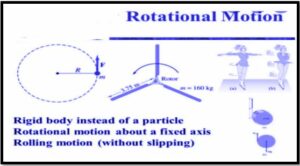Table of Contents
“Rotational motion is defined as the motion of an item in a fixed orbit around a circular route.” The dynamics of rotating motion are quite similar to those of linear or translational motion.
A Brief Outline
Several equations for rotating object mechanics are related to the linear motion equations. Only rigid bodies are addressed in rotational motion. A rigid body is a mass entity that has a rigid shape.
Important Concepts
The body is said to be autorotating or spinning if the rotation axis passes internally through its own centre of mass, and the surface intersection of the axis is called a pole. Revolving or orbiting around a wholly external axis, such as the planet Earth around the Sun, is called whirling or orbiting when it is caused by gravity, and the orbital poles are the endpoints of the rotation axis.
Oscillations in roll, pitch, or yaw, as well as constant-speed rotation when there are head movements, are all examples of rotational motions that are sometimes associated with illness. It can be difficult to consider the impact of rotational oscillation on illness and translational oscillation metrics.
A specific case of rotational motion is rotation around with a fixed axis. The fixed-axis theory rules out the notion of an axis changing its orientation hence wobbling and precession aren’t possible. Euler’s rotation theorem states that simultaneous rotation along multiple stationary axes is impossible; if two rotations are induced at the same moment, a new axis of rotation will appear.
For rotation along a fixed axis, the equations for the object’s kinetic energy and the forces on its pieces are also simpler than for generic rotational motion. Because of this, rotation along a fixed axis is frequently taught after students have mastered linear motion in introductory physics courses; the complete generality of rotational motion is not normally taught in introductory physics programs.

Significance of basic concepts of rotational motion in IIT JEE exam
Because the weighting for rotational motion in the chapter is usually comparable between years, we may expect that the rotational dynamics will be around 3%. As a result, it’s expected that the total number of questions from this chapter would be around 2.
FAQs
Why aren't parallel position vectors taken into account?
Forces that are parallel to the axis produce torques that are perpendicular to the axis and do not need to be considered. Also, only the perpendicular to the axis components of the position vector is taken into account.
What are some real-world examples of rotation around a fixed point?
Rotation about a fixed point occurs in a variety of ways, including ceiling fan rotation, clock minute and hour hand rotation, and door opening and closing.
What are some examples of rotation around a rotation axis?
Translational and rotational motion are both involved in rotation around an axis of rotation. Pushing a button is the finest example of rotation about an axis of rotation.







